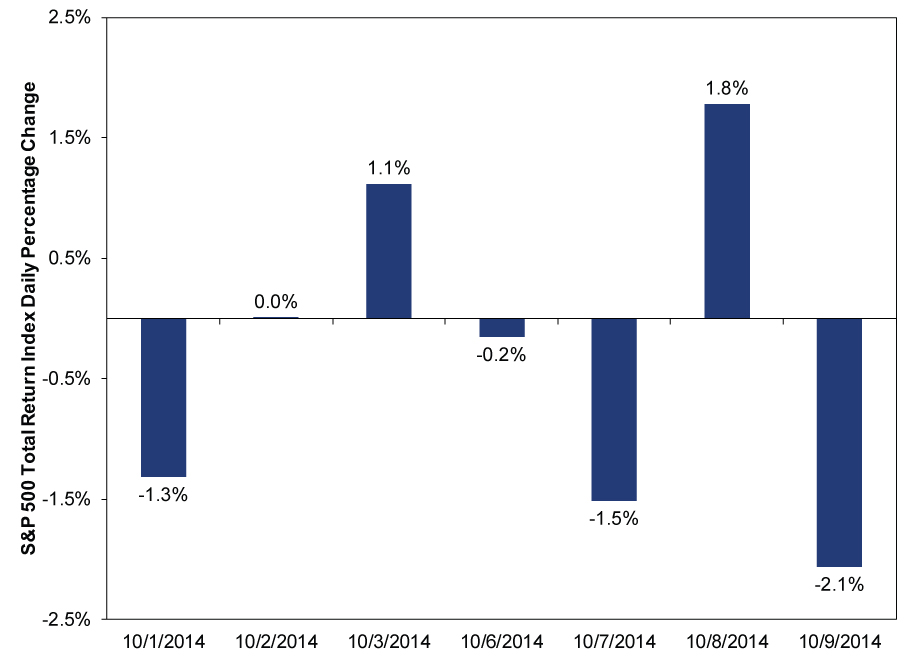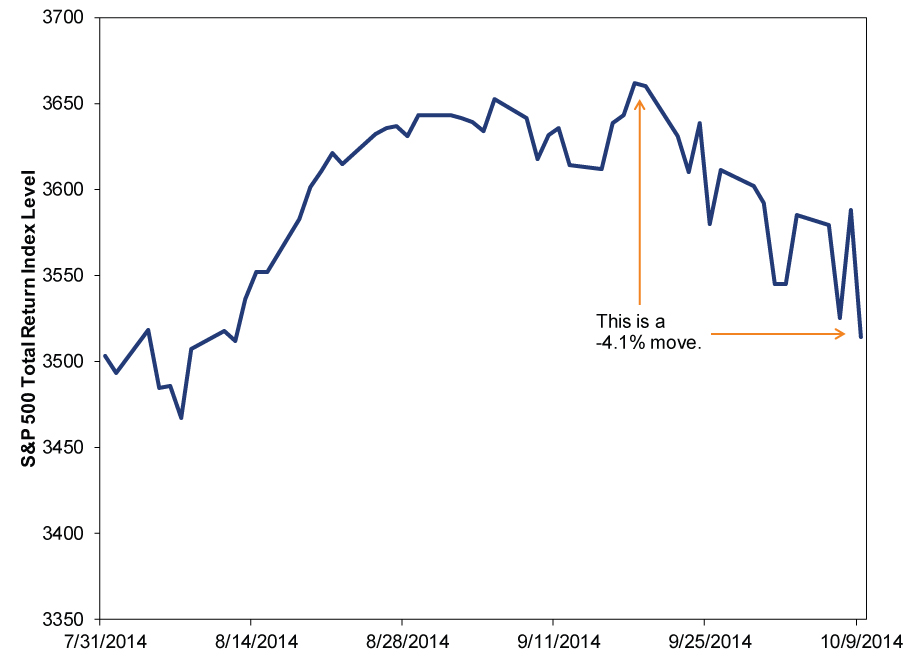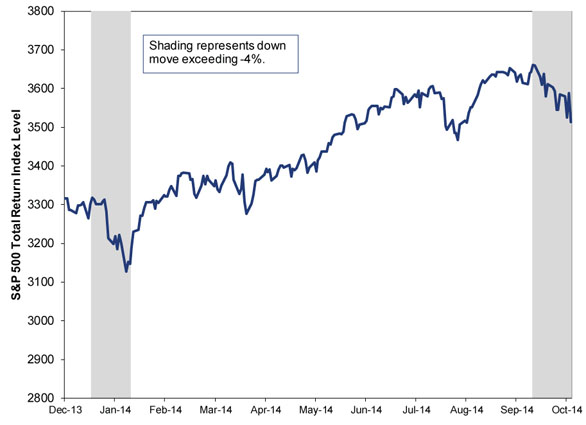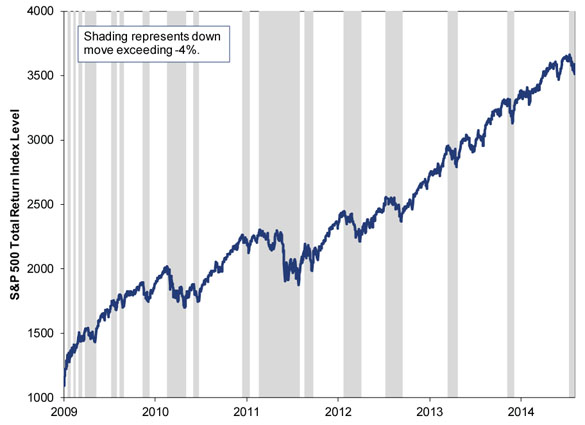Personal Wealth Management / Market Analysis
Putting Stocks’ Zigzags in Broader Perspective
It has been a bouncy start to October, but equity investors must focus on longer time periods than seven trading sessions.
After a big, volatile bounce back Wednesday, in which the S&P 500 surged 1.8%, negativity struck US markets on Thursday, with the S&P 500 down 2.1% on the day.[i] Since October began, the S&P has swung more than 1% up or down five times (two up, three down). The back-and-forth is rather predictably spurring some eye-catching headlines. Here is a small sample so you get the flavor:
- A Market Correction Is 'Definitely Coming'[ii]
- Dow Suffers Worst Selloff in More Than a Year
- US Stocks Erase Year's Best Rally on Growth Concerns
- S&P 500 Lands at Eight-Week Low
- US Stocks Tumble as Volatility Returns[iii]
Interested in market analysis for your portfolio? Our latest report looks at key stock market drivers including market, political, and economic factors. Click Here for More!
However, all these headlines look at either one day or this month's seven trading sessions under a microscope. A broader view can add some very valuable perspective.
Now, nearly all of these cite reasons: The stronger dollar threatening multinationals' profits; eurozone economic data showing a less-than-robust recovery continues; Ebola; the Chinese hard landing; geopolitics. Many posit the question: Are we in a correction-or worse? Exhibit 1 shows the S&P 500's recent swings that are garnering the attention.
Exhibit 1: S&P 500 Total Return Index Daily Percentage Change, October 1 - 9, 2014[iv]
Source: FactSet, as of 10/09/2014.
The negativity we've seen thus far is certainly not fun to weather. And perhaps-just perhaps-it does turn into a correction (a short, sharp, sentiment-driven dip of greater than 10%). Corrections are unpredictable, their beginnings and ends unidentifiable until they're very past-tense. They arrive and exit quickly. No one we have ever come across in this industry has a history of repeatedly identifying them. Corrections do not give off warning signs or red flags. From a peak, they drop fast. From a trough, they rise steep. As for a bear market indicator, consider: In the five bull markets since 1982, there have been 140 single-day drops of -2% or more. [v] 56 came in this bull market-Thursday's is this year's fourth![vi]
While the present may feel correction-like, after Thursday's negative day, stocks sit 4.1% below all-time highs achieved 16 trading sessions ago. In historical bull markets since 1928, stocks have fallen more than the peak-to-present pullback in a single day 52 times.[vii] In this bull market, five single (very volatile) days exceed this. None ended the bull.
Exhibit 2: S&P 500 Total Return Index, 07/31/2014 - 10/09/2014
Source: FactSet, as of 10/09/2014.
The index is still positive for the year by about 6%.The present isn't even the largest dip this calendar year to date! In January and early February, stocks fell by a hair over 5%.
Exhibit 3: S&P 500 Total Return Index, 12/31/2013 - 10/09/2014
Source: FactSet, as of 10/09/2014. Highlighted days are the January/early February negative period.
In this bull market, stocks have fallen more than the present -4.1% on 17 occasions. Yes-a few were amid corrections, but most weren't-and none ended the bull.
Exhibit 4: S&P 500 Total Return Index, 03/09/2009 - 10/09/2014.
Source: FactSet, as of 10/09/2014. Highlighted segments represent 4% or greater down moves.
By no means are we trying to dismiss how volatility can feel. But keeping it in proper perspective is vital. Our brains are hardwired to exaggerate threats, an evolutionary tool for keeping us safe when saber-toothed tigers roamed. Nobel Prize winning professor Daniel Kahneman, in a landmark study, discovered prospect theory, a sense that investors tend to feel losses about 2.5 times as much as they appreciate gains. But markets cannot be gamed via fight or flight instincts. They tend to blind investors to the broad picture, eschewing positivity in the name of a hyper-fixation on very short-term fears. Prospect theory has another, more telling name, too: myopic loss aversion. This is the effect media targets. This is why headlines focus on not only daily results, but intraday results. It is our sincere hope that if you invest in stocks the time horizon for your assets is longer than a matter of hours, days or months. If that's true, your focus should probably come closer to matching it than the headlines.
Stock Market Outlook
Like what you read? Interested in market analysis for your portfolio? Why not download our in-depth analysis of current investing conditions and our forecast for the period ahead. Our latest report looks at key stock market drivers including market, political, and economic factors. Click Here for More!
[i] Source: FactSet, S&P 500 Total Return for 10/8/2014.
[ii] Except for one stock, which the same source told the public is significantly undervalued.
[iii] It is worth noting that Wednesday's 1.7% up move was just about as volatile as Thursday's 2.0% down move. Volatility is directionless.
[iv] We omitted 10/4 and 10/5 because they are a Saturday and Sunday. Stocks have never traded on Sundays, and haven't traded on Saturdays in more than 50 years.
[v] Source: FactSet, S&P 500 Price Returns, -2% or greater down days in the periods: 08/12/1982 - 08/25-1987; 12/04/1987 - 07/16/1990; 10/11/1990 - 03/24/2000; 10/09/2002 - 10/09/2007; and 03/09/2009 - 10/09/2014.
[vi] Source: FactSet, S&P 500 Price Returns, -2% or greater down days in the periods: 08/12/1982 - 08/25-1987; 12/04/1987 - 07/16/1990; 10/11/1990 - 03/24/2000; 10/09/2002 - 10/09/2007; and 03/09/2009 - 10/09/2014.
[vii] Source: FactSet, S&P 500 Price Returns, -4% or greater down days in the 13 bull markets since 1928.
If you would like to contact the editors responsible for this article, please message MarketMinder directly.
*The content contained in this article represents only the opinions and viewpoints of the Fisher Investments editorial staff.
Get a weekly roundup of our market insights
Sign up for our weekly e-mail newsletter.

You Imagine Your Future. We Help You Get There.
Are you ready to start your journey to a better financial future?

Where Might the Market Go Next?
Confidently tackle the market’s ups and downs with independent research and analysis that tells you where we think stocks are headed—and why.









